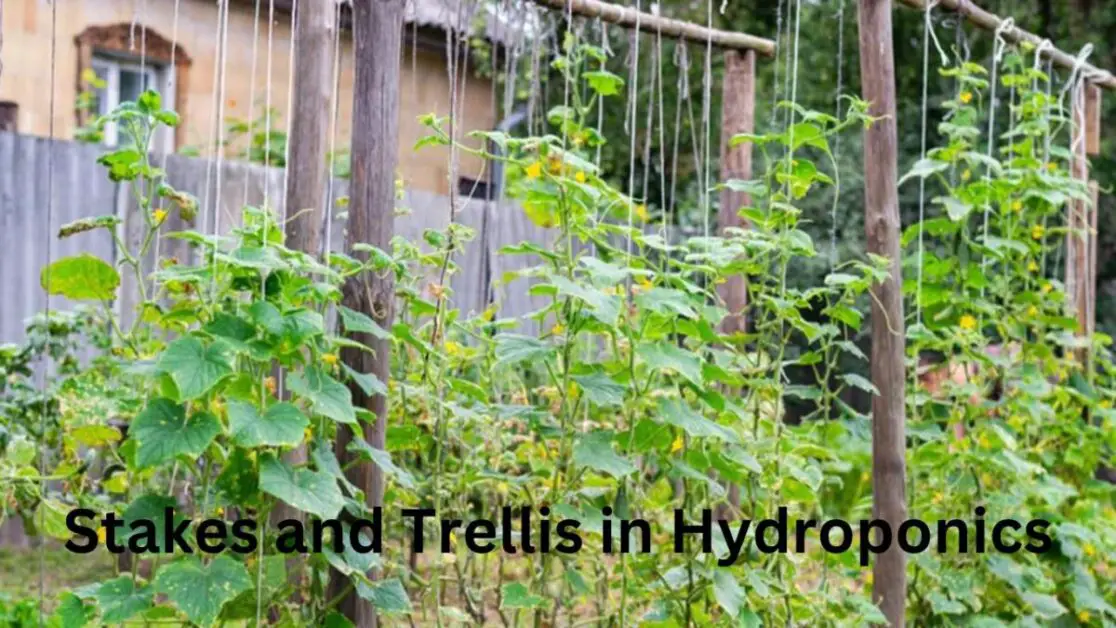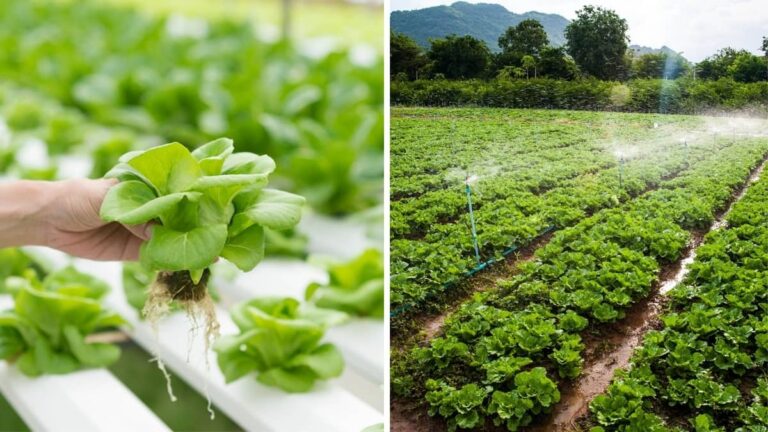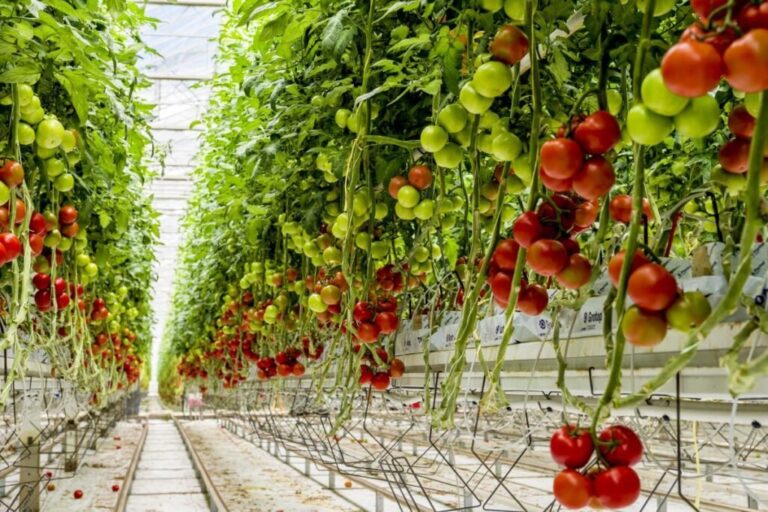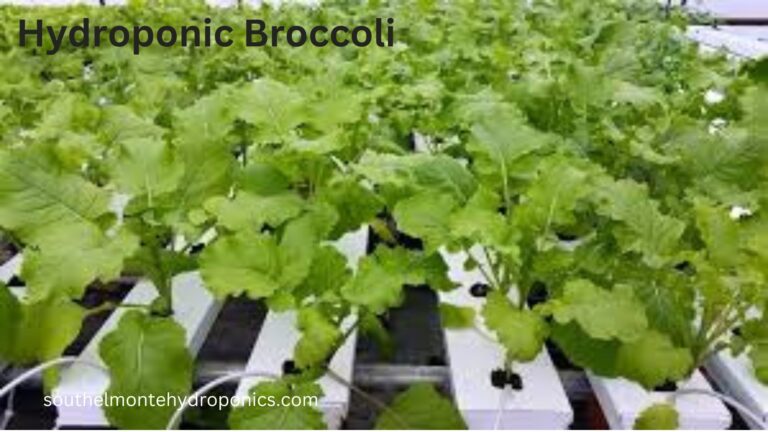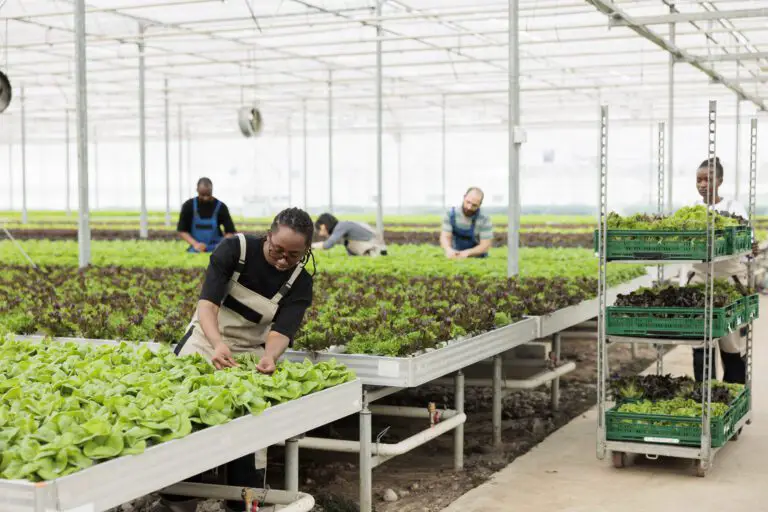Best Way to Support Your Plants with Stakes and Trellis in Hydroponics
Table of Contents: Stakes and Trellis in Hydroponics
Exploring the significance of providing support for hydroponic plants: Stakes and Trellis in Hydroponics
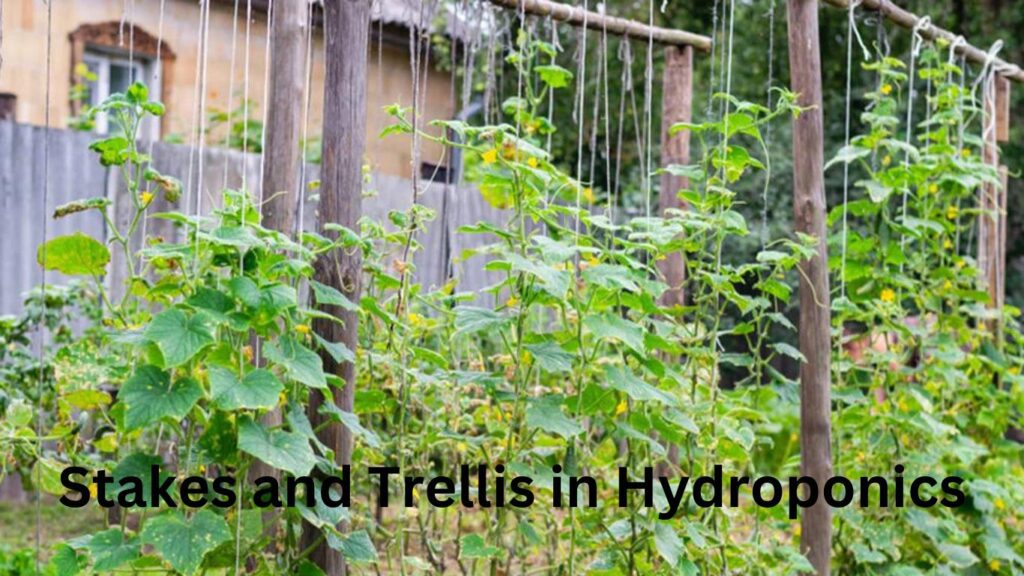
Providing support for hydroponic plants is of utmost significance in ensuring their healthy growth and optimal productivity. Hydroponic systems rely on nutrient-rich solutions and a controlled environment to support plant growth, but without proper support, plants may suffer from various issues such as weak stems, toppling over, or inadequate light exposure.
One key benefit of providing support is the prevention of stem breakage. Hydroponic plants, especially those with heavy fruit or foliage, have a greater risk of bending or breaking under their weight. By using stakes or trellis systems, gardeners can provide physical support to help plants maintain an upright position and distribute the weight more evenly. This not only protects the plants from potential damage but also ensures the continuous supply of nutrients and water, allowing them to reach their full growth potential. Additionally, supporting hydroponic plants can also enhance air circulation around the foliage, reducing the risk of diseases caused by excessive moisture or poor ventilation.
Furthermore, the use of support structures such as stakes or trellis systems can help optimize light exposure for hydroponic plants. By lifting the plants off the ground and positioning them at an appropriate height, sunlight or artificial lights can reach more parts of the plant, including lower leaves that may otherwise be shaded. This improved light distribution promotes better photosynthesis, leading to stronger and more productive plants. Additionally, increased light exposure can also help reduce the risk of fungal or bacterial diseases by creating a drier environment for hydroponic plants.
In conclusion, providing proper support for hydroponic plants is crucial for their overall health and productivity. It helps prevent stem breakage, promotes optimal light exposure, and improves air circulation around the foliage. By utilizing stakes or trellis systems, gardeners can ensure that their hydroponic plants grow vigorously, produce abundant yields, and flourish in their controlled environment.
– Prevention of stem breakage
– Enhanced air circulation around foliage
– Optimal light exposure for better photosynthesis
– Reduced risk of fungal or bacterial diseases
– Highlighting the benefits of using Stakes and Trellis in Hydroponics systems
Using stakes and trellis systems in hydroponics has numerous benefits that can significantly enhance the growth and productivity of your plants. Stakes provide structural support to the plants, ensuring that they remain upright and stable as they grow. By supporting the stems, stakes help prevent bending, breaking, and damage caused by the weight of fruits or vegetables. This support not only promotes healthy growth but also improves air circulation, which reduces the risk of disease and allows for efficient nutrient absorption.
Trellis systems, on the other hand, offer a versatile solution for managing vine and climbing plants in hydroponic gardens. They provide a framework for the plants to climb or trail, maximizing vertical space and minimizing the likelihood of entanglement or overcrowding. By training plants to grow vertically, trellis systems enable better light exposure to all plant parts, leading to more uniform growth and improved photosynthesis. Additionally, trellises facilitate easier access for maintenance tasks such as pruning, harvesting, and pest control, making overall plant management more convenient and efficient.
Both stakes and trellis systems contribute to the overall health and productivity of hydroponic plants. By understanding their benefits and utilizing them effectively, you can optimize your gardening efforts and achieve impressive results in your hydroponic setup.
• Stakes provide structural support, ensuring plants remain upright and stable
• Prevent bending, breaking, and damage caused by the weight of fruits or vegetables
• Promote healthy growth and improve air circulation
• Reduce the risk of disease and allow for efficient nutrient absorption
• Trellis systems offer a versatile solution for managing vine and climbing plants
• Provide a framework for plants to climb or trail, maximizing vertical space
• Minimize entanglement or overcrowding of plants
• Enable better light exposure to all plant parts, leading to more uniform growth
and improved photosynthesis
• Facilitate easier access for maintenance tasks such as pruning, harvesting,
and pest control
By utilizing stakes and trellis systems effectively in hydroponic gardening:
– Overall health and productivity of plants can be enhanced.
– Gardening efforts can be optimized.
– Impressive results can be achieved in hydroponic setups.
Identifying the Ideal Time to Provide Support Stakes and Trellis in Hydroponics
Providing support for hydroponic plants is crucial for their healthy growth and optimum yield. Identifying the ideal time to provide support is essential in ensuring that your plants receive the assistance they need at the right stage of their growth cycle.
One key indicator for determining the ideal time for plant support is observing the plant’s size and weight. As your hydroponic plants start to grow and develop foliage, they may become top-heavy, making them prone to bending or even breaking. This is especially true for plants that produce large and heavy fruits or flowers. By closely monitoring your plants’ growth and assessing their weight-bearing capacity, you can proactively anticipate when additional support will be necessary.
Another factor to consider is the plant’s development stage. Different plants have varying growth patterns, and it’s important to understand the specific requirements of each plant species you cultivate. Some plants may require support early on as they establish their roots, while others may benefit from support during the fruiting or flowering stage. By being familiar with your plants’ growth habits and consulting reliable resources, you can determine the optimal timing for providing support and ensure that it aligns with their developmental milestones.
By paying close attention to plant size and weight as well as the stage of development, you can identify the ideal time to provide support for your hydroponic plants. This proactive approach will not only prevent plant damage but also promote healthy growth, increase productivity, and ultimately enhance your overall gardening experience. So, keep a watchful eye and be ready to offer the necessary assistance when your plants need it the most.
• Observing the plant’s size and weight is crucial in determining the ideal time for support.
• Hydroponic plants that become top-heavy are prone to bending or breaking.
• Plants producing large and heavy fruits or flowers may require additional support.
• Monitoring growth and assessing weight-bearing capacity helps anticipate when support will be necessary.
• Considering the plant’s development stage is important for providing timely support.
• Different plants have varying growth patterns, requiring specific timing of support.
• Some plants may need early root establishment support, while others benefit from fruiting or flowering stage assistance.
• Familiarity with your plants’ growth habits and reliable resources can help determine optimal timing for support.
By paying attention to plant size, weight, and development stage, you can identify when to provide hydroponic plant supports. This proactive approach prevents damage and promotes healthy growth. It increases productivity and enhances overall gardening experience. Stay vigilant and offer assistance when needed most.
Stakes and Trellis in Hydroponics- Recognizing when plants need support in their growth cycle
Plants, much like humans, go through various stages of growth and development. It is during these growth cycles that they may require additional support to ensure their health and vitality. One key factor to consider is the weight of the plant as it grows and the potential strain it may place on its own structure. Thin, delicate stems may begin to bend or even break under the weight of heavy foliage or fruit, leading to a significant decrease in overall plant health.
Another indicator that a plant may need support is when it starts to show signs of stress. This can manifest in a variety of ways, such as sagging branches or drooping leaves. These signs of strain can be indicative of insufficient support systems in place. By recognizing these early warning signs, gardeners can intervene and provide the necessary support to prevent further complications and promote healthy growth.
In summary, it is crucial for gardeners to closely monitor their plants’ growth cycles and recognize when additional support may be necessary. By doing so, they can intervene at the appropriate time, providing the necessary aid to ensure the plants thrive and produce an abundant harvest.
• Thin, delicate stems may bend or break under the weight of heavy foliage or fruit
• Sagging branches and drooping leaves are signs of stress and insufficient support
• Recognizing these early warning signs allows gardeners to intervene and provide necessary support
• Monitoring plant growth cycles is crucial for identifying when additional support is needed
• Providing timely aid ensures plants thrive and produce a bountiful harvest.
Observing signs of stress or strain that indicate the need for additional support Stakes and Trellis in Hydroponics
Plants, like any living organisms, exhibit various signs and behaviors that can indicate their need for additional support. In the case of hydroponic plants, it is crucial to observe any signs of stress or strain that may arise as they grow. One of the most common indicators is the bending or drooping of plant stems, which suggests that the plant is struggling to support its own weight. This is especially prevalent in plants with large, heavy fruits or in those with weak stems that cannot withstand the weight of their produce.
Another sign to look out for is the leaning or tilting of plants, either towards one side or towards a light source. This imbalance can occur when the plant’s structure is overwhelmed by the weight distribution or when it instinctively tries to position itself for better access to sunlight. Additionally, if you notice a plant struggling to maintain an upright position and constantly swaying, it is likely an indication that it lacks stability and requires additional support.
By closely monitoring these signs of stress and strain within your hydroponic system, you can address the issue promptly by providing the necessary support. Doing so will not only prevent the plants from collapsing or breaking under their own weight, but it will also ensure a healthier and more productive growth cycle.
• Bending or drooping of plant stems: This indicates that the plant is struggling to support its own weight, especially in plants with large fruits or weak stems.
• Leaning or tilting of plants: Imbalance can occur due to weight distribution or when the plant tries to position itself for better access to sunlight.
• Swaying and lack of stability: If a plant constantly sways and struggles to maintain an upright position, it likely requires additional support.
By closely monitoring these signs, prompt action can be taken to provide the necessary support. This will prevent plants from collapsing or breaking and ensure a healthier and more productive growth cycle.
Choosing the Right Stakes and Trellis in Hydroponics Plants
When it comes to choosing the right stakes for your hydroponic plants, there are a few key factors to consider. First and foremost, you’ll want to think about the material of the stakes. While there are various options available, such as wood, metal, and plastic, it’s important to select a material that is durable and can withstand the unique conditions of hydroponics.
Additionally, you’ll want to take into account the height and strength requirements of your plants. Some plants may be taller and heavier than others, so it’s crucial to choose stakes that can provide adequate support. It’s also worth considering the weight of the waterlogged growing medium in hydroponic systems, as this can add extra strain on the stakes.
By carefully selecting the right stakes for your hydroponic plants, you can ensure that they receive the necessary support for optimal growth and health. Whether it’s a sturdy wooden stake for smaller plants or a robust metal stake for larger ones, investing in the right stakes can make all the difference in the success of your hydroponic garden.
• Consider the material of the stakes – wood, metal, or plastic
• Choose a durable material that can withstand hydroponic conditions
• Take into account the height and strength requirements of your plants
• Select stakes that can provide adequate support for taller and heavier plants
• Consider the weight of the waterlogged growing medium in hydroponic systems
and its impact on stake durability
• Investing in the right stakes ensures optimal growth and health for your plants
Stakes and Trellis in Hydroponics- Exploring different stake materials and their suitability for hydroponics
Stake materials play a crucial role in providing support for hydroponic plants, ensuring their healthy growth and development. When selecting stake materials for your hydroponic system, it is important to consider factors such as durability, water resistance, and compatibility with plant roots.
One commonly used stake material in hydroponics is bamboo. Renowned for its strength and flexibility, bamboo stakes can effectively support a variety of plants. Additionally, bamboo is resistant to rotting, making it a long-lasting option for your hydroponic garden. Another suitable material for stake construction is PVC pipes. These pipes are durable, lightweight, and resistant to water damage, making them an excellent choice for supporting hydroponic plants. PVC pipes can be easily cut and shaped according to the size and height requirements of your plants, providing optimal support throughout their growth cycle.
In addition to bamboo and PVC, metal stakes are another option to consider. Metal stakes, such as galvanized steel or stainless steel, are extremely sturdy and can withstand heavy loads, making them ideal for supporting larger plants or those with substantial fruits or flowers. However, it is important to note that metal can heat up under intense lighting, potentially affecting plant root temperature. Therefore, it is advisable to use metal stakes in conjunction with insulation or shading materials to mitigate this potential issue.
Overall, the choice of stake material depends on various factors, including the specific needs of your plants and the environmental conditions in your hydroponic system. By carefully considering these factors, you can select the most suitable stake material to provide optimal support, ensuring the healthy growth and success of your hydroponic plants.
• Bamboo stakes are a popular choice due to their strength, flexibility, and resistance to rotting.
• PVC pipes are durable, lightweight, and resistant to water damage, making them an excellent option for supporting hydroponic plants.
• Metal stakes, such as galvanized steel or stainless steel, provide exceptional sturdiness and can withstand heavy loads.
• Metal stakes may heat up under intense lighting, so insulation or shading materials should be used in conjunction with them.
Stakes and Trellis in Hydroponics- Considering the height and strength requirements of your plants when selecting stakes
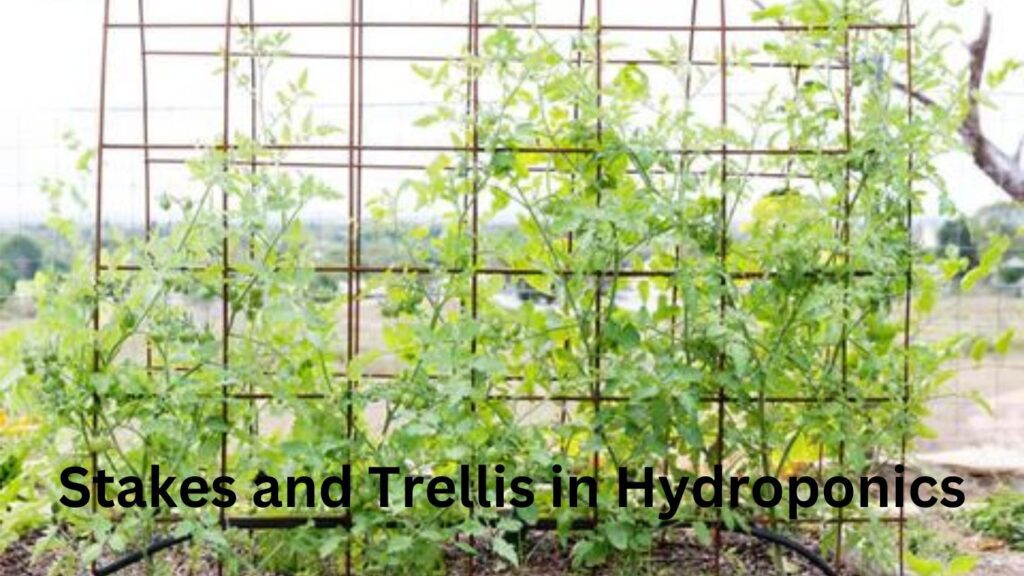
When selecting stakes for your hydroponic plants, it is essential to consider their height and strength requirements. Different plants have varying growth habits and structures, and understanding these characteristics is crucial in providing optimal support.
Firstly, consider the height of your plants. Tall or vining plants such as tomatoes, cucumbers, or beans will require longer stakes to accommodate their upward growth. The stakes should be tall enough to reach the desired height of the plant, allowing it to grow vertically without bending or toppling over. Additionally, plants with heavy fruits or dense foliage may require sturdier stakes to bear the weight and prevent drooping. By matching the height requirements, you can ensure that the stakes provide adequate support throughout the plant’s growth cycle.
Secondly, assess the strength needs of your plants. Some plants, like delicate herbs or leafy greens, may not exhibit vigorous growth or heavy structures that demand robust stakes. In these cases, lightweight materials such as bamboo or plastic stakes can be sufficient. However, for plants that are more substantial or require extra stability, consider using stronger stakes made of materials like metal or wood. These materials lend the necessary support and durability to withstand the weight or pressure that might otherwise cause the plants to collapse or sway. By selecting stakes that align with the strength requirements of your plants, you can ensure a stable and healthy growing environment.
• Tall or vining plants like tomatoes, cucumbers, or beans require longer stakes to accommodate their upward growth.
• Stakes should be tall enough to reach the desired height of the plant and prevent bending or toppling over.
• Plants with heavy fruits or dense foliage may require sturdier stakes to bear the weight and prevent drooping.
• Lightweight materials like bamboo or plastic stakes can be sufficient for delicate herbs or leafy greens.
• For more substantial plants or those that require extra stability, consider using stronger stakes made of metal or wood.
Understanding the Different Types of Stakes and Trellis in Hydroponics Systems
Trellis systems play a crucial role in providing support for hydroponic plants, allowing them to grow vertically and maximize their space. There are different types of trellis systems available, each with its own unique features and benefits. One popular type is the vertical trellis, which consists of a sturdy framework that plants can climb on. This type of trellis is ideal for vine-like plants, such as tomatoes and cucumbers, as it helps them grow upwards and keeps their fruits off the ground, reducing the risk of diseases and pests.
Another commonly used trellis system is the A-frame trellis, which consists of two angled supports that form a triangular shape. This type of trellis is beneficial for supporting heavier plants, such as melons or squash, as it provides stability and prevents the plants from bending or breaking under their own weight. The A-frame design also allows for easy access to the plants for pruning or harvesting.
It is important to choose the right type of trellis system based on the specific needs of your plants and the available space in your hydroponic setup. By understanding the different types of trellis systems and their advantages, you can provide optimal support for your hydroponic plants and ensure their healthy growth and productivity.
• Vertical trellis:
– Consists of a sturdy framework for plants to climb on
– Ideal for vine-like plants like tomatoes and cucumbers
– Helps plants grow upwards and keeps fruits off the ground, reducing disease and pest risks
• A-frame trellis:
– Consists of two angled supports forming a triangular shape
– Provides stability for heavier plants like melons or squash
– Prevents bending or breaking under plant’s weight
– Allows easy access for pruning or harvesting
Choosing the right trellis system:
– Consider the specific needs of your plants
– Assess available space in your hydroponic setup
Benefits of understanding different types of trellis systems:
– Optimal support provided for hydroponic plants
– Ensures healthy growth and productivity
Stakes and Trellis in Hydroponics- Introducing trellis systems and their role in plant support
Trellis systems play a crucial role in providing support for hydroponic plants and optimizing their growth. These structures are designed to train plants to grow vertically, allowing them to make efficient use of space and light. By providing a framework for plants to climb and spread, trellis systems promote better air circulation, minimize the risk of disease, and facilitate easier maintenance and harvesting.
One of the main benefits of using trellis systems in hydroponics is their ability to maximize productivity. As plants grow vertically along the trellis, they can develop more branches and bear a greater number of fruits or flowers. This vertical growth also allows for better light penetration throughout the plant, resulting in more uniform and consistent growth. Additionally, trellis systems help to prevent plants from sprawling on the ground, reducing the risk of damage and facilitating efficient nutrient uptake.
In conclusion, the use of trellis systems is essential for supporting hydroponic plants and maximizing their potential. These structures not only provide a sturdy framework for plants to grow vertically, but they also contribute to increased productivity and improved plant health. By incorporating trellis systems into your hydroponic setup, you can create a thriving garden that yields abundant and high-quality produce.
• Trellis systems are designed to train plants to grow vertically, optimizing space and light usage.
• They promote better air circulation, minimizing the risk of disease in hydroponic plants.
• Trellis systems facilitate easier maintenance and harvesting by providing a framework for plants to climb and spread.
• These structures maximize productivity by allowing plants to develop more branches and bear a greater number of fruits or flowers.
• Vertical growth along trellises ensures better light penetration throughout the plant, resulting in more uniform and consistent growth.
• Trellis systems prevent plants from sprawling on the ground, reducing the risk of damage and facilitating efficient nutrient uptake.
Comparing various Stakes and Trellis in Hydroponics designs and their benefits
In hydroponic systems, trellis designs play a crucial role in providing support for plants and maximizing their growth potential. There are various trellis designs available, each with its own unique benefits in the context of hydroponics.
One common trellis design is the single-string system, where a single string is tied horizontally at a certain height to support the plant. This design is particularly suitable for vining plants like tomatoes and cucumbers. By guiding the plant’s growth along the string, the single-string trellis helps prevent the plants from sprawling on the ground, ensuring better access to light and improving air circulation around the foliage.
Another popular trellis design is the V-shaped system, which involves positioning two strings in a V shape to support the plant’s stems as they grow upward. This design is especially effective for crops like beans and peas. The V-shaped trellis provides excellent stability to the plants, allowing them to grow vertically and optimizing space utilization in hydroponic gardens.
Regardless of the chosen trellis design, it is important to regularly monitor the plants’ growth and adjust the trellis system accordingly. This will ensure that the plants receive adequate support throughout their growth cycle, promoting healthy development and higher yields.
• The single-string trellis design is suitable for vining plants like tomatoes and cucumbers
• It prevents the plants from sprawling on the ground, improving access to light and air circulation
• The V-shaped trellis design is effective for crops like beans and peas
• It provides stability to the plants, allowing them to grow vertically and optimize space utilization in hydroponic gardens
• Regular monitoring of plant growth is important to adjust the trellis system accordingly
• This ensures adequate support throughout the growth cycle, promoting healthy development and higher yields.
Preparing Your Plants for Stakes and Trellis in Hydroponics Installation
To ensure the successful installation of stakes and trellises in your hydroponic system, it is crucial to properly prepare your plants. Taking the time to adequately prune and train your plants will maximize the effectiveness of these support structures, leading to healthier and more productive growth.
Pruning is an essential step in plant preparation as it helps control the size and shape of your plants. By removing excess or damaged foliage, you allow for better air circulation and light penetration, which promotes optimal growth. Additionally, pruning encourages the development of strong and sturdy stems, which will provide a solid foundation for the stakes and trellises.
Training your plants involves gently guiding their growth patterns to ensure they align with the support structures you plan to install. This process can be accomplished by gently bending or tying the stems to the stakes or trellises as they grow. Supporting the plants in a controlled manner will help prevent them from leaning or flopping over once the structures are in place.
By properly preparing your plants through pruning and training, you are setting them up for success when installing stakes and trellises in your hydroponic system. This step is crucial for achieving optimal support and ensuring the continued health and productivity of your plants.
• Pruning is essential for controlling plant size and shape
• Removing excess or damaged foliage improves air circulation and light penetration
• Encourages the development of strong stems for support structures
• Training plants involves guiding their growth patterns to align with supports
• Gently bending or tying stems to stakes or trellises helps prevent leaning or flopping over
• Proper preparation through pruning and training sets plants up for success in hydroponic system installation
• Crucial step for achieving optimal support, health, and productivity
Stakes and Trellis in Hydroponics- Ensuring your plants are ready for support structures
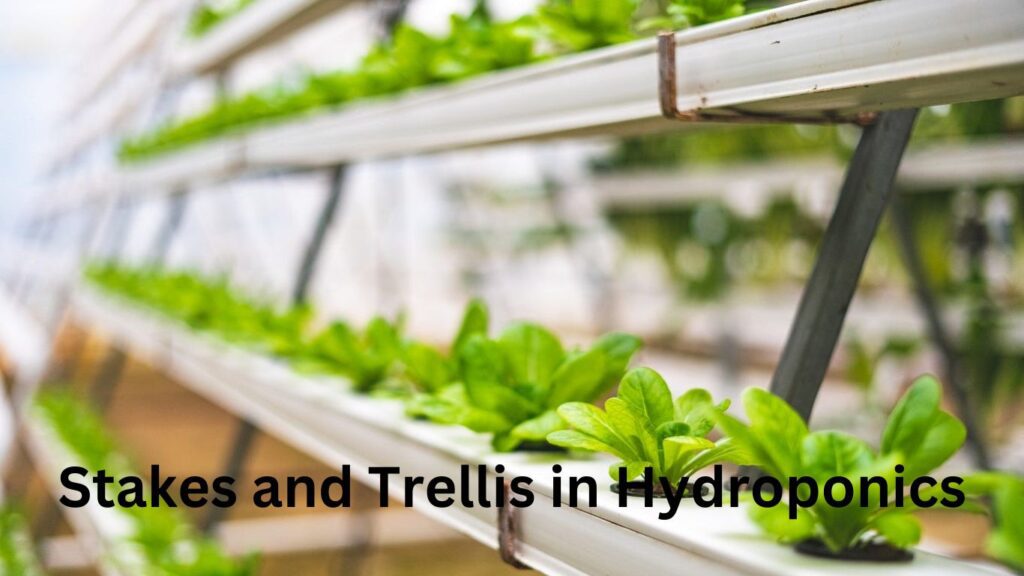
To ensure that your hydroponic plants are ready for support structures, it is essential to consider their growth stage and overall health. Before installing stakes or trellis systems, take the time to assess the plants’ development and make any necessary preparations.
Firstly, evaluate the height and strength requirements of your plants. Different varieties have specific growth patterns and support needs, so it’s crucial to understand these characteristics. Measure the height of your plants and determine if they require stake support to prevent bending or breaking under their own weight. Additionally, consider the strength of the stems and branches. Thicker and sturdier plants may require more robust support systems, such as trellises, while delicate or fragile plants may only need minimal stakes to guide their growth.
Secondly, examine the overall health of your plants. Ensure that they are free from pests, diseases, or nutrient deficiencies that could hinder their growth or make them more susceptible to stress. Before installing support structures, address any issues that could compromise the plant’s ability to thrive. Regular monitoring and maintenance are key to identifying and resolving problems promptly, allowing your plants to establish a strong foundation for successful growth with the aid of stakes or trellises.
• Evaluate the height and strength requirements of your plants
– Measure the height of your plants to determine if stake support is needed
– Consider the strength of stems and branches for appropriate support systems
• Examine the overall health of your plants
– Ensure they are free from pests, diseases, or nutrient deficiencies
– Address any issues before installing support structures
• Regular monitoring and maintenance are key to identifying and resolving problems promptly
Pruning and training your plants to maximize the effectiveness of Stakes and Trellis in Hydroponics
Pruning and training your plants in a hydroponic system is crucial for maximizing the effectiveness of stakes and trellis. By carefully managing the growth of your plants, you can promote better airflow, reduce disease risks, and enhance overall productivity.
One important aspect of pruning is removing excessive foliage. As plants grow, they can become dense and overcrowded, which restricts air circulation and increases the chances of mold, mildew, or pest infestations. By selectively removing leaves, especially those growing close to the base of the plant, you can create a more open canopy that allows for better light penetration and airflow.
Training your plants involves gently guiding their growth along the stakes or trellis system. This prevents the plants from sprawling on the ground and reduces the risk of stems breaking or fruit being damaged. By gently tying the stems to the stakes or trellis using plant ties or soft garden twine, you can promote upright growth, ensure proper support, and enhance the distribution of nutrients throughout the plant.
Overall, through pruning and training, you can create a well-structured and efficiently supported hydroponic garden, leading to healthier plants and higher yields.
• Pruning and training your plants in a hydroponic system is crucial for maximizing the effectiveness of stakes and trellis.
• Managing the growth of your plants promotes better airflow, reduces disease risks, and enhances overall productivity.
• Removing excessive foliage helps create a more open canopy for better light penetration and airflow.
• Selectively removing leaves close to the base of the plant prevents overcrowding and restricts air circulation.
• Training your plants involves gently guiding their growth along stakes or trellis systems.
• This prevents sprawling on the ground, reducing stem breakage and fruit damage.
• Tying stems to stakes or trellises using plant ties or soft garden twine promotes upright growth and proper support.
• Enhancing nutrient distribution throughout the plant leads to healthier plants with higher yields.
Stakes and Trellis in Hydroponics Installing Properly for Optimal Support
When it comes to installing stakes for optimal support in your hydroponic system, it is crucial to ensure that you do it properly to maximize the effectiveness of this support structure. First and foremost, it is important to select stakes that are suitable for your specific hydroponic plants. Different stake materials have varying levels of durability and strength, so choose wisely based on the requirements of your plants. Additionally, consider the height and weight of your plants when selecting stakes, as taller and heavier plants will require sturdier stakes to provide adequate support.
Once you have chosen the appropriate stakes, the next step is to insert them into your hydroponic system correctly. Begin by identifying the location where your plants need support and gently insert the stakes into the growing medium near the base of the plants. Take care not to damage the delicate roots of your plants during this process. In order to secure the stakes firmly, you can use plant clips or plastic ties to fasten the stems or branches of your plants to the stakes. This will ensure that they remain upright and supported throughout their growth cycle. By following these steps, you can install stakes properly and provide your hydroponic plants with the optimal support they need for healthy and robust growth.
• Select stakes that are suitable for your specific hydroponic plants
• Consider the height and weight of your plants when selecting stakes
• Insert the stakes into the growing medium near the base of the plants
• Take care not to damage the delicate roots of your plants during insertion
• Use plant clips or plastic ties to secure stems or branches to the stakes
for added support
Stakes and Trellis in Hydroponics- Explaining the correct way
When it comes to supporting hydroponic plants, the correct way to insert stakes into the system is crucial. By following proper techniques, you can ensure optimal support for your plants and promote their healthy growth.
Firstly, it is essential to choose stakes that are suitable for hydroponics and the specific needs of your plants. Sturdy materials such as bamboo, plastic, or metal are commonly used for stakes due to their durability and resistance to moisture. Consider the height and strength requirements of your plants when selecting stakes, as different varieties may have varying support needs.
Once you have chosen the appropriate stakes, insert them into the hydroponic system carefully. Start by locating the desired location for each stake, making sure to avoid damaging any nearby plant roots. Gently push the stake into the growing medium, such as perlite or rockwool, at a slight angle towards the plant’s base. Ensure that the stake is securely anchored in the medium to provide stability and support throughout the plant’s growth cycle.
Remember, stakes are just one aspect of plant support in hydroponics. In the next section, we will explore the various trellis systems available and their role in promoting optimum growth.
• Choose stakes made of sturdy materials such as bamboo, plastic, or metal
• Consider the height and strength requirements of your plants when selecting stakes
• Locate the desired location for each stake without damaging nearby plant roots
• Gently push the stake into the growing medium at a slight angle towards the plant’s base
• Ensure that the stake is securely anchored in the medium for stability and support
Stakes and Trellis in Hydroponics play a crucial role in supporting plants and helping them grow vertically. Here’s a simple table outlining the key aspects of stakes and trellises in hydroponics:
| Aspect | Stakes in Hydroponics | Trellises in Hydroponics |
|---|---|---|
| Purpose | Provide vertical support for individual plants. | Support and guide the growth of climbing plants. |
| Material | Typically made of plastic, metal, or bamboo. | Often constructed from plastic, metal, or wood. |
| Installation | Inserted into the growing medium (e.g., substrate). | Positioned within the hydroponic system, fixed or movable. |
| Function | Supports the main stem of plants to prevent sagging or bending. | Guides the growth of vining plants, ensuring proper exposure to light. |
| Application | Commonly used for tomatoes, peppers, and other tall, heavy-bearing plants. | Suitable for crops like cucumbers, peas, and beans that tend to climb. |
| Adjustability | Fixed in place, may require repositioning as the plant grows. | Can be adjusted in height or moved to accommodate plant growth. |
| Space Efficiency | Takes up minimal space, suitable for compact systems. | Allows efficient use of vertical space, maximizing growing area. |
| Maintenance | Low maintenance, occasional adjustment as the plant grows. | May require periodic checking and adjustment as plants climb and develop. |
| Cost | Relatively low-cost compared to trellis systems. | Cost may vary based on materials and complexity. |
Remember, the choice between stakes and trellises depends on the specific needs of the plants you are growing and the available space in your hydroponic setup.
Stakes and Trellis in Hydroponics- Demonstrating techniques to secure stakes firmly without damaging plant roots
When it comes to securing stakes firmly in a hydroponic system, it is essential to prioritize the health and integrity of the plant’s roots. By following the correct techniques, you can ensure that your plants receive the support they need without causing any harm.
Firstly, it is crucial to choose the right stakes for your hydroponic plants. Opt for stakes made of lightweight, durable materials such as bamboo or plastic. These materials provide sufficient support while minimizing the risk of root damage. Additionally, consider the height and strength requirements of your plants when selecting stakes. Taller plants or those with heavy fruits may require sturdier stakes to withstand the pressure.
Once you have chosen the appropriate stakes, the next step is to insert them into the hydroponic system correctly. Carefully position the stake near the base of the plant, ensuring that it reaches deep into the growth media or substrate. Take caution not to disturb or damage the roots during the process. To further secure the stake, you can use plant ties or gentle loops of string to anchor the plant and prevent any unnecessary movement. By following these methods, you can provide the necessary support for your hydroponic plants without risking damage to their delicate root systems.
• Choose stakes made of lightweight, durable materials such as bamboo or plastic
• Consider the height and strength requirements of your plants when selecting stakes
• Insert the stake near the base of the plant, reaching deep into the growth media or substrate
• Take caution not to disturb or damage the roots during stake insertion
• Use plant ties or gentle loops of string to anchor the plant and prevent unnecessary movement
How do stakes and trellis systems benefit hydroponic plants?
Stakes and trellis systems provide support for hydroponic plants, helping them maintain an upright position and preventing them from collapsing under the weight of their foliage or fruit. This support also ensures proper air circulation and sunlight exposure, which are essential for healthy plant growth.
When is the ideal time to provide support for Stakes and Trellis in Hydroponics plants?
The ideal time to provide support for hydroponic plants is when they start to show signs of growth and require additional support to maintain their upright position. This usually occurs during the vegetative or flowering stage, depending on the plant species.
How can I recognize when my plants need support in their growth cycle?
Look for signs such as drooping leaves, bending stems, or plants leaning heavily to one side. These are indications that your plants are in need of additional support to prevent damage and promote optimal growth.
What are some signs of stress or strain that indicate the need for additional support?
Signs of stress or strain include plant stems bending or breaking, leaves turning yellow or brown, and reduced overall plant vigor. These signs indicate that the plants are experiencing difficulty supporting themselves and require additional support.
What should I consider when choosing Stakes and Trellis in Hydroponics plants?
When selecting stakes, consider the height and strength requirements of your plants. Choose stakes that are tall enough to support the plant’s height and sturdy enough to withstand the weight of the plant and its foliage.
What are the different stake materials suitable for hydroponics?
Some suitable stake materials for hydroponics include bamboo, plastic, metal, or wooden stakes. Each material has its advantages and disadvantages, so choose the one that best suits your specific needs and preferences.
What is the role of systems in supporting Stakes and Trellis in Hydroponics plants?
Trellis systems provide a framework for plants to grow and climb, offering support for their growth and preventing them from sprawling on the ground. They also help maximize space utilization and make it easier to manage and harvest the plants.
What are the benefits of using Stakes and Trellis in Hydroponics?
Using trellis systems in hydroponics helps increase airflow around the plants, reduce the risk of fungal diseases, and improve light penetration into the canopy. It also allows for better plant training and pruning, resulting in higher yields and healthier plants.
How can I prepare my plants for stake and Stakes and Trellis in Hydroponics installation?
Before installing stakes or trellis systems, ensure your plants are properly pruned and trained. Remove any excess foliage or side shoots that may hinder the effectiveness of the support structures. This will maximize the benefits of using stakes and trellis systems.
What are the proper techniques to secure Stakes and Trellis in Hydroponics without damaging plant roots?
To secure stakes without damaging plant roots, gently insert the stake into the growing medium near the base of the plant. Avoid piercing or damaging the roots in the process. Use soft ties or plant clips to secure the plant to the stake, ensuring it is firmly supported without causing harm.

